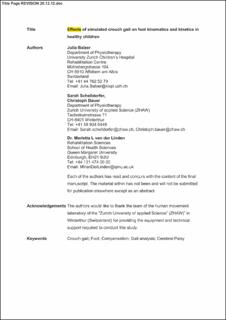Please use this identifier to cite or link to this item:
https://doi.org/10.21256/zhaw-2705Full metadata record
| DC Field | Value | Language |
|---|---|---|
| dc.contributor.author | Balzer, Julia | - |
| dc.contributor.author | Schelldorfer, Sarah | - |
| dc.contributor.author | Bauer, Christoph | - |
| dc.contributor.author | van der Linden, Marietta L. | - |
| dc.date.accessioned | 2018-08-08T08:49:26Z | - |
| dc.date.available | 2018-08-08T08:49:26Z | - |
| dc.date.issued | 2013 | - |
| dc.identifier.issn | 0966-6362 | de_CH |
| dc.identifier.issn | 1879-2219 | de_CH |
| dc.identifier.uri | https://digitalcollection.zhaw.ch/handle/11475/8914 | - |
| dc.description.abstract | Identification of secondary and tertiary impairments in neurologically induced gait deviations, such as crouch gait, is not always straightforward, but essential in order to decide upon the most efficient medical treatment in patients with cerebral palsy (CP). Until now, exact intersegmental dependency of the development of foot deformities has not been investigated. Therefore, the aim of this study was to explore if an artificially induced bilateral knee flexion contracture causes compensatory mechanisms in foot motion during gait in healthy children. Three-dimensional kinematic and kinetic data from 30 healthy children (mean age 10.6 years) were derived from the Oxford Foot model (OFM). Participants walked first in an artificially induced crouch gait (limitation of knee extension to 40°) and then normally. Walking speed was kept the same in both conditions. Analysis revealed small but significant (p<0.05) differences between the two conditions in hindfoot and forefoot kinematics in all three planes during the stance phase as well as for all peak internal moments within the foot. In general the foot tended to compensate for an artificial knee flexion contracture with an increase in maximal dorsiflexion, eversion and external rotation of the hindfoot, which also allowed increased foot motion in other foot segments. The results of this study showed that an isolated proximal joint contracture had an influence on foot position during stance in healthy children. Further interpretation of the data in relation to CP children will be possible as soon as comparable OFM data of pathological crouch gait is available. | de_CH |
| dc.language.iso | en | de_CH |
| dc.publisher | Elsevier | de_CH |
| dc.relation.ispartof | Gait & Posture | de_CH |
| dc.rights | Licence according to publishing contract | de_CH |
| dc.subject | Cerebral palsy | de_CH |
| dc.subject | Compensation | de_CH |
| dc.subject | Crouch gait | de_CH |
| dc.subject | Foot | de_CH |
| dc.subject | Gait analysis | de_CH |
| dc.subject | Adolescent | de_CH |
| dc.subject | Biomechanical Phenomena | de_CH |
| dc.subject | Cerebral Palsy | de_CH |
| dc.subject | Child | de_CH |
| dc.subject | Contracture | de_CH |
| dc.subject | Female | de_CH |
| dc.subject | Foot | de_CH |
| dc.subject | Foot Joints | de_CH |
| dc.subject | Gait | de_CH |
| dc.subject | Gait Disorders, Neurologic | de_CH |
| dc.subject | Healthy Volunteers | de_CH |
| dc.subject | Humans | de_CH |
| dc.subject | Kinetics | de_CH |
| dc.subject | Knee Joint | de_CH |
| dc.subject | Male | de_CH |
| dc.subject | Orthotic Devices | de_CH |
| dc.subject | Patient Simulation | de_CH |
| dc.subject | Range of Motion, Articular | de_CH |
| dc.subject.ddc | 610: Medizin und Gesundheit | de_CH |
| dc.subject.ddc | 618.92: Pädiatrie | de_CH |
| dc.title | Effects of simulated crouch gait on foot kinematics and kinetics in healthy children | de_CH |
| dc.type | Beitrag in wissenschaftlicher Zeitschrift | de_CH |
| dcterms.type | Text | de_CH |
| zhaw.departement | Gesundheit | de_CH |
| dc.identifier.doi | 10.21256/zhaw-2705 | - |
| dc.identifier.doi | 10.1016/j.gaitpost.2013.02.009 | de_CH |
| dc.identifier.pmid | 23473807 | de_CH |
| zhaw.funding.eu | No | de_CH |
| zhaw.issue | 4 | de_CH |
| zhaw.originated.zhaw | Yes | de_CH |
| zhaw.pages.end | 624 | de_CH |
| zhaw.pages.start | 619 | de_CH |
| zhaw.publication.status | submittedVersion | de_CH |
| zhaw.volume | 38 | de_CH |
| zhaw.publication.review | Peer review (Publikation) | de_CH |
| Appears in collections: | Publikationen Gesundheit | |
Files in This Item:
| File | Description | Size | Format | |
|---|---|---|---|---|
| 2013_Bauer_Effects_of_simulated_crouch_gait.pdf | 382.27 kB | Adobe PDF |  View/Open |
Show simple item record
Balzer, J., Schelldorfer, S., Bauer, C., & van der Linden, M. L. (2013). Effects of simulated crouch gait on foot kinematics and kinetics in healthy children. Gait & Posture, 38(4), 619–624. https://doi.org/10.21256/zhaw-2705
Balzer, J. et al. (2013) ‘Effects of simulated crouch gait on foot kinematics and kinetics in healthy children’, Gait & Posture, 38(4), pp. 619–624. Available at: https://doi.org/10.21256/zhaw-2705.
J. Balzer, S. Schelldorfer, C. Bauer, and M. L. van der Linden, “Effects of simulated crouch gait on foot kinematics and kinetics in healthy children,” Gait & Posture, vol. 38, no. 4, pp. 619–624, 2013, doi: 10.21256/zhaw-2705.
BALZER, Julia, Sarah SCHELLDORFER, Christoph BAUER und Marietta L. VAN DER LINDEN, 2013. Effects of simulated crouch gait on foot kinematics and kinetics in healthy children. Gait & Posture. 2013. Bd. 38, Nr. 4, S. 619–624. DOI 10.21256/zhaw-2705
Balzer, Julia, Sarah Schelldorfer, Christoph Bauer, and Marietta L. van der Linden. 2013. “Effects of Simulated Crouch Gait on Foot Kinematics and Kinetics in Healthy Children.” Gait & Posture 38 (4): 619–24. https://doi.org/10.21256/zhaw-2705.
Balzer, Julia, et al. “Effects of Simulated Crouch Gait on Foot Kinematics and Kinetics in Healthy Children.” Gait & Posture, vol. 38, no. 4, 2013, pp. 619–24, https://doi.org/10.21256/zhaw-2705.
Items in DSpace are protected by copyright, with all rights reserved, unless otherwise indicated.